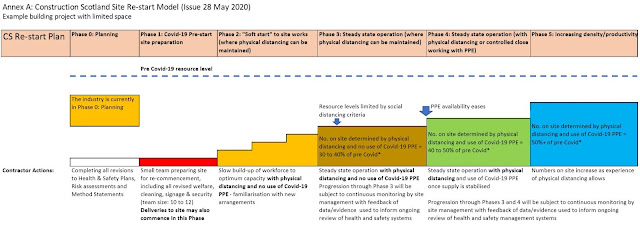The 21th of may the Scottish Government announced the 6-step phased approach to re-open the non-essential sites. The phases proposed are the following ones:
- Phase 0: Planning
- Phase 1: Covid-19 Pre-start Site prep
- Phase 2: “Soft start” to site works (only where physical distancing can be maintained)
- Phase 3: Steady state operation (only where physical distancing can be maintained)
- Phase 4: Steady state operation (where physical distancing can be maintained and/or with PPE use)
- Phase 5: Increasing density/productivity with experience
One week after, on May 29th the Government
announced that the no-essential works could start to move to Phase 1. Under
this phase, contractors can begin to prepare the sites to “facilitate the physical distancing and enhanced hygiene, including
Installing new or expanding existing site welfare and toilet facilities, “one
way” systems and marking 2m distancing throughout the site”.
During the first week of June, several companies [1] [2] [3]
have been adapting their sites to the next phase. However, even the health and
safety requirements are satisfied, progressing to Phase 2 is far from being automatic.
The government must be consulted before proceeding to the ‘soft start’ phase
(Phase 2), and it must be in line with public health advice. Also, Phase 2
will not take place until a minimum of 2
weeks after the updated advice is published. After more than one week of site preparations (from the 29thof
May), such announces have not been published yet, so it is unlikely to move to
the next phase in two weeks’ time.
Furthermore, most of the works will not be able to be
carried out in Phase 2. The guide remarks that in Phase 2 “no element of non-essential works requiring the use of PPE above the
standard industry use, will commence at this stage”. As I understand, the
soft start permits only a limited number of people to work when physical
distancing can be maintained, and no special coronavirus PPE is needed.
The details of phase 3 will be issued within the Phase 2
update. As well as the previous stage, in phase 3 only works than can ensure
physical distancing without the need of PPE could be carried out. It is
suggested that under this phase, only 30% or 40% of the original workforce will
be able to return depending on the site parameters. The objective of this phase
is monitoring a supervising the activity to reach a steady-state operation.
Therefore, the interchange of information between the sites and the Government
would be essential in this phase.
In Phase 4, PPE could be used to ensure physical distance,
and consequently, more workforce will be able to return to the sites. This
phase only will be possible if the supply of the PPE equipment is guaranteed. Around
10% of the original workforce is expected to return thanks to the use of PPE, which
means 40-50% of workers on site.
Lastly, in Phase 5, the workforce will be increased progressively based on the experience gathered in the previous phases.
The guide sets a long journey for sites to return safely to
work as we remember. According to the MSP Kevin Stewart, progress beyond these stages will clearly depend on a range of factors,
including the industry’s ability to demonstrate fully compliant working
practices in place, the confidence of the workforce and its trade union
representatives in those arrangements, and wider supporting health data.
The following image summarizes the re-start model.
Construction Scotland re-start model

No comments:
Post a Comment